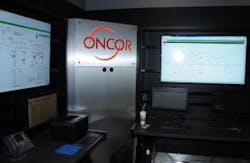Schneider Electric’s microgrid controller brings intelligence to Oncor’s sophisticated microgrid.
A misconception exists that it’s easy to develop a microgrid because it is a relatively small, local source of energy.
But a microgrid’s size belies its complexity. Microgrids are not a plug-and-play technology; intead they are highly customized, built to suit the kind of client they serve, anything from a building to a campus to a community.
“They’ve got to be very flexible and scalable because each client has unique requirements, based on the sources of generation that they have and the types of load they have — and the complexities of those loads,” said Mark Liston, vice president for energy solutions at Schneider.
The client’s interconnection strategies also add to the complexity, as does the facility’s scale and size, he said.
So in planning a microgrid, it’s important to understand the customer’s existing energy system. That’s not always easy because some have outdated schematics, particularly municipalities, added Jeff Worley, manager for engineered solutions at Schneider.
“If you are going to add additional current flowing through the circuits, you better know about how close you are to the capacity,” he said.
It’s also important to consider the level of intelligence the microgrid will require. Microgrid software and controls are growing in sophistication and can manage generation and load in increasingly complex ways. Not all controllers maximize system efficiencies. An advanced microgrid can consider a range of variables — such as weather, pricing, available resources — to leverage the best mix of onsite power, grid power, or possibly energy storage at any given time.
Like an orchestra conductor
Liston compared a sophisticated microgrid controller — such as Schneider’s — to an orchestra conductor, coordinating into one symphony the various forms of supply and demand; the generation, utility supply, and buildings.
In addition to having the right intelligence, the microgrid must have the right hardware. Knowing how to develop a microgrid — what to include in the infrastructure — requires a deep understanding of power systems, Liston said.
“When you apply a microgrid solution to a client’s system there are all types of considerations regarding coordination,” he said. This might include retrofitting an existing system, making modifications to existing switchgear, or other changes that allow it to run in island or grid-connected mode. “So power system expertise is an extremely important competency.”
And last, it’s crucial that the microgrid developer or operator creates a strategy that bridges both supply and demand; a microgrid represents a convergence of the two. This includes sourcing and securing energy for the microgrid and advising on electric and gas contracts, as well as demand-side management.
Indeed, energy efficiency is a “foundational element” of a microgrid, Worley said. By saving energy, the customer may be able to install less generation and therefore lower the microgrid’s capital costs.
A microgrid is a sort of mini-grid, but on a much smaller scale. It includes many elements of the larger grid. Ultimately, a good microgrid developer must be an expert across many energy specialties.
The acumen to develop a microgrid
“These projects require groups of people to communicate with each other and work together that often don’t speak the same language or even use the same terms for the same thing,” Worley said.
Large companies like Schneider employ a range of experts, so are able to overcome the language barrier without outsourcing. “Because we work both on the supply and demand side, we can talk to the utility in their language and end user in their language and prime mover suppliers in their language,” he said.
So yes, microgrids bring energy control closer to home. But installing the microgrid is no home handyman task. Instead, it’s a complex engineering job that requires an understanding of energy technology, markets and language.
“It is about managing power and the controls associated with both generation and load management; it’s a piece of the business we’ve been in a long time,” Liston said. “Within Schneider, we have the hardware, software and competence.”
This is Part 2 of a two-part Schneider Electric executive interview. See Part 1 here.
What other complexities come into play in developing a microgrid? Comment below or on our LinkedIn Group, Microgrid Knowledge.
About the Author
Elisa Wood
Editor-in-Chief
Elisa Wood is the editor and founder of EnergyChangemakers.com. She is co-founder and former editor of Microgrid Knowledge.
